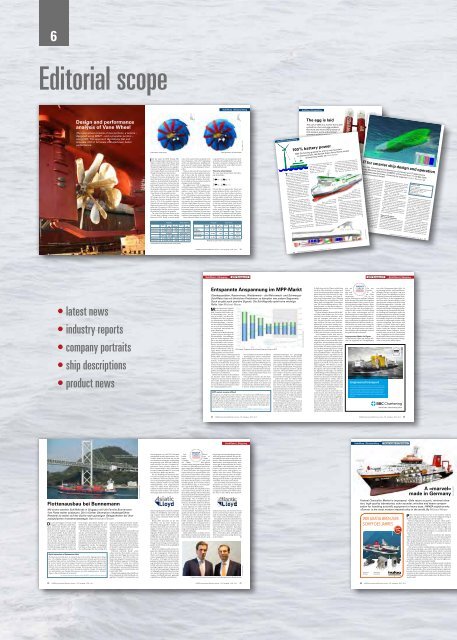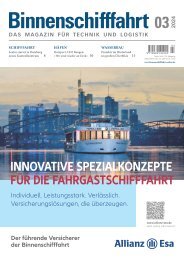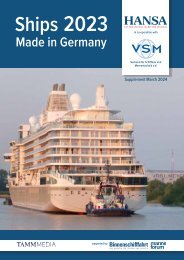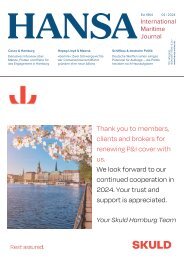Create successful ePaper yourself
Turn your PDF publications into a flip-book with our unique Google optimized e-Paper software.
6<br />
Schiffbau | Shipbuilding<br />
48 HANSA International Maritime Journal – 152. Jahrgang – 2015 – Nr. 8<br />
Schiffbau | Shipbuilding<br />
The egg is laid<br />
The use of LNG as a marine fuel is still<br />
curbed by a hen-and-egg problem.<br />
But more and more LNG-projects of<br />
ship owners, ports and terminal<br />
operators point to a change<br />
Europe<br />
• German shipyard Fr. Fassmer has built<br />
the EU’s first LNG-powered vessel, a ferry<br />
for the island of Helgoland. The ship<br />
is 83 m long, 13 m wide and has a draft<br />
of 3.6 m and carries 1,180 passengers, ten<br />
10-ft-containers and mixed cargo. The<br />
5,000 kW engines provides a top speed<br />
of 20 kn. Shipping company Cassen Eils<br />
got an EU-subsidy of 4.175 mill. €. Total<br />
cost was 30 mill. €.<br />
• With start of operations scheduled for<br />
2017, Bomin Linde will build an LNG-terminal<br />
in the port of Hamburg and a<br />
7,000 m3 LNG-bunkering vessel, expected<br />
to be ordered in Q3 2015. The vessel<br />
will also transport LNG to the Klaipedos<br />
Nafta reloading station in Klaipeda, being<br />
developed by 2017. In Stockholm,<br />
Linde group already operates »AGA Seagas«,<br />
the world’s first LNG-fueling vessel,<br />
built with TEN-T funding to fuel the<br />
cruise ship »Viking Grace«.<br />
• Becker Marine Systems and AIDA Cruises<br />
developed an LNG hybrid barge for the<br />
port of Hamburg. »Hummel« works as a<br />
floating power plant, using LNG to generate<br />
electricity to supply ships at berth.<br />
• AIDA Cruises has ordered two LNG-powered<br />
cruise vessels with Meyer Werft in<br />
Papenburg, Germany. The 180,000 gtships<br />
will be delivered in 2019 and 2020,<br />
estimated order value is 1.5 bill. €. Meanwhile<br />
Meyer Turku in Finland is building<br />
a fast LNG-ferry for Tallink’s Tallinn-Helsinki<br />
service. The 212 m long<br />
49,000 gt-ship will carry 2,800 passengers<br />
and will cost about 230 mill. €. It will have<br />
a top speed of 27 kn, delivery is scheduled<br />
for early 2017.<br />
• Dutch shipyard DBI Borkum is building<br />
the world’s first LNG-powered hopper<br />
barge for bremenports. The German<br />
ports company gets 1.65 mill. € of<br />
EU-funding for the 4.9 mill. € order. The<br />
hopper barge will be 70 m long and 10 m<br />
wide with a loading capacity of 850 m3.<br />
Earlier, HGM Energy announced to<br />
build an LNG-bunkering facility in Bremen’s<br />
industrial port by 20<strong>16</strong>.<br />
• The Port of Antwerp renewed plans for<br />
an LNG bunkering facility for barges.<br />
Currently, only truck-to-vessel operation<br />
is possible. Originally the port<br />
wanted to build the 450 m3 facility and<br />
then find a licencee to operate it. Now it<br />
looks for a company to do both. By<br />
2019 the terminal will be operational.<br />
• By defining the Dutch and German<br />
ports of Groningen Seaports and Niedersachsen<br />
Ports as one port region,<br />
bunkering facilities shall be developed<br />
more efficiently. Seen individually, both<br />
groups are unlikely to be eligible for EU<br />
funding. Thus, with support of Energy<br />
Valley, a common approach has been developed.<br />
• United European Car Carriers (UECC)<br />
has ordered two LNG-powered Pure<br />
Car/Truck Carriers (PCTCs). Powered<br />
by an MAN dual-fuel engine, they will<br />
be capable of completing a 14-day round<br />
trip operating solely on LNG. UECC has<br />
signed an exclusive contract for the supply<br />
of LNG in Zeebrugge. The vessels<br />
will be constructed at NACKS shipyard,<br />
China. Delivery is scheduled for the second<br />
half of 20<strong>16</strong>.<br />
• Gate terminal Rotterdam is building an<br />
LNG break bulk infrastructure, including<br />
berthing and loading facilities<br />
dedi cated to bunkerships and smaller<br />
tankers. Based on a multi-user service<br />
model, the facilities will have a capacity<br />
of 280 berthing slots per year. First operations<br />
are planned towards the end of<br />
20<strong>16</strong>. Shell has committed to buy capacity<br />
from Gate and has ordered an LNG<br />
bunker vessel, to supply ships in Northwest<br />
Europe. The ship will be built by<br />
South Korean STX Offshore & Shipbuilding.<br />
• DEME ordered two trailing suction hopper<br />
dredgers equipped with dual-fuel engines<br />
and LNG tanks that will be built<br />
by Dutch shipyard Royal IHC. They will<br />
be operational before the end of 20<strong>16</strong>.<br />
Hopper volume will be approx.<br />
8,000 m3 and 3,000 m3, respectively.<br />
• Sirius Veder Gas AB has ordered a<br />
5,800 m3 LNG bunker and feeder vessel<br />
with Dutch shipyard Royal Bodewes for<br />
distribution of LNG in the Baltic area.<br />
The joint venture of Anthony Veder<br />
Group and Sirius Rederi will operate the<br />
vessel for Skangass under a long term<br />
charter. It will be delivered in February<br />
2017.<br />
Photos: Fjord Line, Fassmer, Tallink, AB Gotland, Crowley, FSG<br />
HANSA International Maritime Journal – 152. Jahrgang – 2015 – Nr. 3 53<br />
IT for smarter ship design and operation<br />
The 14th International Conference on Computer and IT Applications<br />
in the Maritime Industries (COMPIT) will be held from 11–13 May 2015<br />
in Ulrichshusen/Germany. A preview by organizer Volker Bertram of<br />
Tutech Innovation GmbH<br />
F irst held in the year 2000, COMPIT has<br />
established itself as a key conference in<br />
information technology (IT) for the maritime<br />
industries, bringing together software<br />
developers and users. Most participants<br />
come from industry, reflecting the practical<br />
relevance of th event. The main trends<br />
in IT for the maritime industries are E-navigation<br />
as precursor to unmanned ships, Super,<br />
Mega, Exa – Redefine supercomputing<br />
and Big data enters the scene.<br />
E-navigation (or sea traffic management)<br />
can be seen as a maritim equivalen to air<br />
traffic control. Many tasks of nautical planning<br />
and monitoring are then shifting to<br />
land-based control centers. E-navigation is<br />
a key step towards unmanned shipping. In<br />
para lel, unmanned surface vessels are used<br />
as platforms to develop and test algorithms<br />
for autonomous navigation. It seems as if it<br />
is only a matter of time before we wi l indeed<br />
see unmanned cargo ships. Computing<br />
power continues to grow exponentia ly. This<br />
opens new applications. CFD is one technology<br />
that is particularly greedy in terms of<br />
computational power. Frontier applications<br />
already use massive computer architectures<br />
with 200,000 cores in para lel. The third<br />
trend, Big data, uses simpler algorithms,<br />
but huge amounts of data. Processing a l this<br />
data is no the problem anymore. Turning<br />
the data into useful information is the challenge.<br />
Applications appear in fleet operation<br />
and inte ligent maintenance schemes.<br />
COMPIT covers three fu l days. Traditiona<br />
ly each day is dedicated to a major<br />
phase in the lifecycle of ships:<br />
Day 1 – ship design with sessions on:<br />
»hu l models«, »simulation-based design«,<br />
»coupled simulations«, and »high-performance<br />
computing for CFD«<br />
Day 2 – ship lifecycle management and<br />
production with sessions on: »product lifecycle<br />
management«, »IT for ship production<br />
& ship repair«, »Virtual & augmented reality«,<br />
»marine (swarm) robotics«<br />
Day 3 – ship operation with sessions on:<br />
»Ship routing«, »Big data & Performance insight«,<br />
»Sea traffic management«, »Towards<br />
unmanned shipping«<br />
Ships are 3D objects –<br />
right from the beginning<br />
3D ship mode ling has been advocated since<br />
the very first Compit in the year 2000. Quiet<br />
and continuous work marked the way, and<br />
now 3D mode ling in ship design has been<br />
chosen as the opening session of Compit<br />
2015. A bit boring, isn’t it? Not for the expert<br />
… and neither for the accountant. 3D mode<br />
ling is the backbone of a l simulations and<br />
virtual reality applications, the glamorous<br />
sisters in the advanced IT application family.<br />
And 3D model save time and money, seriously.<br />
Cabos and Tietgen (DNV GL) demonstrate<br />
this convincingly in »3D Ship Design<br />
from the Start – An Industry Case Study«.<br />
Th extra effort for creating a 3D model in<br />
the early design phase is more than balanced<br />
by the higher efficiency in subsequen tasks.<br />
The paper describes coupling NAPA Steel<br />
and POSEIDON for model re-use and the<br />
application in an actual newbuilding project<br />
of a major Korean shipyard.<br />
Darren Larkins et al. (SSI) suppor the<br />
same message in »Utilizing a Single 3D<br />
Product Model through the Design Process«.<br />
Their paper shows the advantages<br />
gained by various companies that have<br />
utilized this approach via the Marine Information<br />
Model in SSI’s ShipConstructor<br />
software. Lindner et al. (Rostock Universi-<br />
COMPIT 2015<br />
www.compit.info<br />
Venue: Schloss Ulrichshusen/Germany<br />
Participation fee: 600 € + VAT<br />
Registration by email to:<br />
Volker Bertram<br />
volker.bertram@dnvgl.com<br />
Source: FRIENDSHIP Systems<br />
CFD is often combined with optimisation to obtain extra fuel savings<br />
Editorial scope<br />
Schifffahrt | Shipping<br />
Schifffahrt | Shipping<br />
HANSA International Maritime Journal – 152. Jahrgang – 2015 – Nr. 5 25<br />
24 HANSA International Maritime Journal – 152. Jahrgang – 2015 – Nr. 5<br />
Entspannte Anspannung im MPP-Markt<br />
Überkapazitäten, Ratenniveau, Wettbewerb – die Mehrzweck- und Schwergut-<br />
Schifffahrt hat mit ähnlichen Problemen zu kämpfen wie andere Segmente.<br />
Doch es gibt auch positive Signale. Die Schiffsgröße spielt eine wichtige<br />
Rolle. Von Michael Meyer<br />
M ag das Segment im Vergleich<br />
zu den drei großen Märkten<br />
Bulk, Container und Tanker relativ<br />
überschaubar sein – eine Nische<br />
ist die MPP- und Heavylift-<br />
Schifffahrt nicht. Mit Transporten<br />
von beispielsweise Stahl, Röhren,<br />
Windenergieanlagen, Generatoren<br />
oder anderen Großkomponenten<br />
ist sie für die weltweite Industrie<br />
und deren Entwic<strong>kl</strong>ung von<br />
großer Bedeutung.<br />
Dadurch ist der Markt allerdings<br />
genauso wenig vor den Folgen von<br />
wirtschaftlichen Entwic<strong>kl</strong>ungen<br />
gefeit wie andere Segmente. Auch<br />
gibt es durchaus Wechselwirkungen<br />
mit der Bulker- und Containerbranche,<br />
weil bestimmte Ladungen<br />
mit verschiedenen Schiffstypen befördert<br />
werden können, wenn der<br />
eigene Markt schwächelt und die<br />
Ladekapazitäten mit Alternativen<br />
gefüllt werden müssen. Dementsprechend<br />
erlebten MPP- und Schwergutreeder – viele<br />
von ihnen in Deutschland und Nordeuropa<br />
ansässig – in den vergangenen Jahren unruhige<br />
Zeiten. Sowohl Fracht- als auch Charterraten<br />
sackten zum Teil drastisch ab, das<br />
Orderbuch blähte die Flotte auf. Einige Reeder<br />
und Schiffsgesellschaften kamen so in<br />
große Schwierigkeiten und manche kämpfen<br />
bis heute ums Überleben.<br />
Mittlerweile konstatieren Branchenkenner<br />
durchaus wieder positive Signale. Im<br />
Vergleich zu den letzten Jahren scheint sich<br />
eine leichte Entspannung abzuzeichnen.<br />
Doch angesichts diverser Unwägbarkeiten<br />
tun sich die Meisten mit Prognosen schwer.<br />
Die Anspannung bleibt vorerst.<br />
Ein viel diskutierter Punkt ist der Ölpreis<br />
– beziehungsweise dessen zwischenzeitlicher<br />
Sinkflug und sein immer noch vergleichsweise<br />
niedriges Niveau. Denn einerseits<br />
profitiert auch die MPP-Branche von<br />
niedrigeren Bunkerkosten. »In Verbindung<br />
mit einer wachsenden Nachfrage nach Tonnage<br />
und einer zumindest leicht schrumpfenden<br />
Flotte sind das durchaus gute Nachrichten«,<br />
urteilte jüngst Susan Oatway vom<br />
Branchendienst Drewry.<br />
Die Experten erwarten, dass die Nachfrage<br />
nach MPP-Tonnage bis 2019 jährlich<br />
durchschnittlich um 5% wachsen wird – allerdings<br />
ab 2017 stärker als in diesem und<br />
im nächsten Jahr. Die Flotte selbst schrumpfe<br />
derzeit, Neubau-Investitionen würden<br />
Außerdienststellungen nur geringfügig<br />
überschreiten, so Oatway. Für die spezialisierteren<br />
Projektfrachter rechnet sie mit einem<br />
Flottenwachstum von jährlich 3,5% bis<br />
2018. In den vergangenen fünf Jahren waren<br />
den Angaben zufolge 60% der Neubauten<br />
in der Branche Projektschiffe. »Wir glauben,<br />
dass dies ein langfristiger Trend ist«, sagt die<br />
Analystin. »Normale« MPP-Frachter würden<br />
vermehrt verschrottet und nur selten<br />
neu bestellt – allenfalls um Flottenabgänge<br />
mit moderner Tonnage zu kompensieren.<br />
Andererseits führt der Ölpreis-Trend<br />
auch dazu, dass Investitionen in neue Projekte<br />
und Förderanlagen zurückgestellt werden,<br />
weil sie nach aktuellen Bewertungen<br />
nicht mehr mit den erwarteten Einnahmen<br />
gedeckt werden können. In der Öl- und Gasbranche<br />
herrscht derzeit vielerorts Vorsicht<br />
und Ernüchterung. Das wirkt sich spürbar<br />
auf die Transporte von Anlagen, Maschinen<br />
und Komponenten aus, wie verschiedene<br />
Reeder und Operateure bestätigen.<br />
»Viele Projekte liegen auf Eis. Wann sie<br />
letztlich umgesetzt werden, ist sehr schwer<br />
vorherzusagen«, sagt Svend Andersen, CEO<br />
bei BBC Chartering, einem Tochterunternehmen<br />
der Leeraner Reederei Briese und<br />
nach eigenen Angaben Weltmarktführer.<br />
Er hoffe, dass sich der Ölpreis mittelfristig<br />
bei 90 bis 100 $ stabilisiert, weil dann auch<br />
wieder Investitionen getätigt würden. »Ich<br />
glaube aber nicht, dass dies noch 2015 passieren<br />
wird«, so Andersen. Auch Ingo Fischer<br />
vom Konkurrenten Thorco Shipping<br />
hält den Ölpreis für »nicht hilfreich«. »Wir<br />
haben durch zurückgestellte Investitionen<br />
zum Teil Kontraktladung verloren. Allerdings<br />
konnten wir dies durch andere Ladung<br />
kompensieren, die wir sonst hätten<br />
liegen lassen müssen.«<br />
Die Beurteilung des Marktes fällt bei BBC<br />
und Thorco eher nüchtern aus. »Es ist noch<br />
schwierig, hat sich aber stabilisiert, nachdem<br />
das vergangene Jahr besser war als<br />
2013. Sehr gut ist es aber noch lange nicht«,<br />
sagt Andersen. Die Raten seien nicht kostendeckend.<br />
Als Operateur komme man –<br />
ohne große Sprünge – über die Runden. Die<br />
Schiffe brauchen seiner Ansicht nach allerdings<br />
20 bis 25% mehr Einnahmen. Das werde<br />
2015 aber nicht mehr zu realisieren sein.<br />
»Wir kommen zurecht, auch wenn es<br />
noch ein insgesamt bescheidener, eher<br />
stabil schlechter Markt ist«, sagt Fischer.<br />
2014 habe Thorco einen moderaten Verlust<br />
eingefahren. Die Betriebskosten der Schiffe<br />
konnten zwar gedeckt werden. Darüberhinaus<br />
bleibt der Markt jedoch nach wie<br />
vor eine Herausforderung. Thorco verfolgt<br />
nach eigenen Angaben die Strategie »Abwarten<br />
und Beobachten«. »Alle kochen mit<br />
dem gleichen Wasser«, sagt Fischer. In der<br />
Vergangenheit hatte es vereinzelt Kritik an<br />
der Preispolitik des Unternehmens und einem<br />
damit einhergehenden Ratenverfall<br />
gegeben. Zu Unrecht, wie der Thorco-Manager<br />
entgegnet: »Wir können es uns gar<br />
nicht leisten, Preise massiv zu unterbieten.«<br />
Bei eigenen und Charterschiffen müssten<br />
die legitimen Forderungen von Banken<br />
und Schiffseignern berücksichtigt werden.<br />
Die Schiffe im Management fahren in einem<br />
Pool, in dem auch ein Teil der eigenen<br />
Schiffe eingebracht ist. »Daher sind wir<br />
auch bei diesen Schiffen gezwungen, gute<br />
Ergebnisse einzufahren, weil wir uns sonst<br />
ins eigene Fleisch schneiden würden.« Die<br />
rund 90 Frachter umfassende Flotte teilt<br />
sich etwa zu je einem Drittel auf.<br />
Sowohl Andersen als auch Fischer verweisen<br />
darauf, dass überraschenderweise<br />
im ersten Quartal das schon fast traditionelle<br />
»Loch« auf dem Markt ausgeblieben<br />
ist. Grund für großen Optimismus sehen<br />
darin aber beide nicht. »Ein Loch wird es<br />
definitiv noch geben«, ist sich Fischer sicher.<br />
Andersen macht seine zurückhaltende Prognose<br />
unter anderem an einer bestimmten<br />
Ladungsart fest: »Mengen und Raten auf den<br />
Märkten Asien und Südamerika sind derzeit<br />
sehr gut für uns.<br />
Zuletzt<br />
wurden<br />
aber rund 30 bis<br />
40% weni- ger Rohre<br />
transportiert.<br />
Das ist aus<br />
unserer Erfahrung ein wichtiger Indikator<br />
dafür, dass der Markt bald Schwierigkeiten<br />
bekommen könnte. Daher erwarte ich eine<br />
Abschwächung in einigen Monaten.« Rohre<br />
für die Öl- und Gasindustrie sind mit über<br />
1 Mio. t pro Jahr eines der wichtigsten Geschäfte<br />
für die Leeraner. Die Entwic<strong>kl</strong>ung<br />
sei aber schwer vorherzusagen, weil der<br />
Markt manchmal von einen Tag auf den anderen<br />
auf <strong>kl</strong>einste wirtschaftliche oder politische<br />
Gegebenheiten reagiere. »Es gibt einige<br />
Unsicherheiten, beispielsweise was die<br />
Märkte Russland und Brasilien betrifft. Gerade<br />
Brasilien war immer sehr wichtig für<br />
uns. Dort ist es aber derzeit sehr instabil«, so<br />
der CEO. Als Beispiel nennt er die finanziellen<br />
Probleme und Ermittlungen rund um<br />
den großen Petrobras-Konzern.<br />
Angespannter Markt für Eigner<br />
Auf der Seite der Eigner und Tonnage-Provider<br />
ist angesichts der Überkapazitäten<br />
von echter Entspannung keine Rede. »Es<br />
ist schwierig, betriebs- und kapitalkostendeckende<br />
Chartern zu finden«, sagt etwa<br />
Ronald Winter, Geschäftsführer bei der in<br />
Hamburg-Finkenwerder ansässigen Reederei<br />
Heino Winter. In den vergangenen beiden<br />
Jahren seien Charterer spürbar vorsichtiger<br />
geworden, nachdem es im Markt einige<br />
Konsolidierungsprojekte, Rückzüge und<br />
Übernahmen gab – das prominenteste Beispiel<br />
war sicherlich der Niedergang der Bremer<br />
Beluga Group. Nun bemerke die Reederei<br />
allerdings seit Jahresbeginn wieder ein<br />
gestiegenes Interesse an moderner Tonnage<br />
mit leistungsstarkem Geschirr. »Verlässlichkeit<br />
und hohe Ansprüche an Schiffsmanagement<br />
und Zertifizierungen werden wieder<br />
verstärkt nachgefragt und teilweise auch<br />
vergütet«, so Winter. Sollten auf Eis gelegte<br />
Öl- und Offshore-Projekte bald realisiert<br />
werden, würde das dennoch »bestenfalls<br />
auskömmliche Raten« bedeuten. Verantwortlich<br />
dafür sei auch die Überbauung.<br />
Aber: »Verglichen mit der Altersstruktur<br />
der fahrenden Flotte ist das Orderbuch moderat,<br />
so dass wir auf ein gesundes Gleichgewicht<br />
in zwei bis drei Jahren hoffen.«<br />
www.bbc-chartering.com<br />
Engineered transport<br />
With more responsibilities resting on the shoulders of<br />
contractors, managing transport risk is a central factor<br />
to ensure operational and economic project success.<br />
BBC Chartering is determined to help by tendering for<br />
projects, by engineering tailor-made transports and<br />
delivering integrated solutions for any assigned project<br />
spread.<br />
SCHIFFFAHRT<br />
FINANZIERUNG<br />
FORUM<br />
INTERNATIONAL MARITIME JOURNAL<br />
INTERNATIONAL MARITIME JOURNAL<br />
MPP market remains difficult<br />
Overcapacity, low freight rates and competition – the multi-purpose (MPP) and heavy cargo<br />
shipping is struggling with problems similar to other segments. But there are positive signs,<br />
even though market analyses differ in part, explains Michael Meyer. May the segment be<br />
relatively limited compared with the three major markets bulk, container and tanker, however<br />
MPP and heavy-lift shipping is not a niche. Overcapacity is still a big problem. Before<br />
it comes to larger bankruptcies, consolidation projects are more likely in this highly diversified<br />
market. An important factor is the size of vessels.<br />
For further information please contact HANSA: redaktion@hansa-online.de<br />
LONDON | DELHI | SINGAPORE | SHANGHAI<br />
Drewry, 15-17 Christopher Street, London EC2A 2BS, United Kingdom<br />
t: +44 (0) 20 7538 0191 f: +44 (0) 20 7987 9396 e: enquiries@drewry.co.uk<br />
Registered in England No. 3289135 Registered VAT No. 830 3017 77<br />
www.drewry.co.uk<br />
Press Release<br />
Oil prices cast a shadow over multipurpose shipping market<br />
London, UK, 25 March 2015 – Global dry cargo demand growth, forecast at 5% per annum<br />
from 20<strong>16</strong> to 2019, to be offset by falling project cargo volumes over the next twelve to<br />
eighteen months, according to the latest edition of the Multipurpose Shipping Market Review<br />
and Forecaster, published by Drewry Maritime Research.<br />
‘‘The fall in oil prices, coupled with growing demand and a diminishing fleet should be good<br />
news for the multipurpose shipping sector. However, it appears that the flipside of lower<br />
bunker prices is a global decline in oil and gas investment projects. There have already been<br />
reports of fewer project cargoes available for the multipurpose fleet to carry as project<br />
investment has started to slow’’, comments Susan Oatway, Lead Analyst, Drewry Maritime<br />
Research.<br />
With the fall in prices, there is less incentive to invest in oil and gas projects – one of the<br />
largest project cargo sectors. This will, in turn, mean a reduction of available cargo and<br />
slower demand growth for the fleet. ‘‘Our analysis of the fleet shows that the simple<br />
multipurpose fleet is in decline, with little investment beyond replacement tonnage. However<br />
the more advanced vessels, the project carriers, are seeing fleet growth of around 3.5% per<br />
annum to end 2018. It is the cargo for these vessels that is directly affected by this slowdown<br />
in the sector’’, said Oatway.<br />
Drewry suggested fleet development by vessel type to 2017 ('000 dwt)<br />
Source: Drewry Maritime Research<br />
Source: Drewry Maritime Research<br />
Die Drewry-Prognose für die Entwic<strong>kl</strong>ung der Flotte bis 2017<br />
MPP & Heavylift<br />
MPP & Heavylift<br />
BBC Chartering<br />
Schiffbau | Shipbuilding<br />
Schiffbau | Shipbuilding<br />
HANSA International Maritime Journal – 152. Jahrgang – 2015 – Nr. 9 71<br />
Propeller Vane wheel 1<br />
RPS<br />
T<br />
[N]<br />
Q<br />
[N×m]<br />
RPS<br />
T<br />
[N]<br />
Experiment 15.00 76.044 1.868 3.79 –0.339<br />
Calculation 15.00 74.504 1.915 3.76 –1.579<br />
Propeller Vane wheel 2<br />
RPS T[N] Q[N×m] RPS T[N]<br />
Experiment 13.00 49.618 1.269 3.85 –0.154<br />
Calculation 13.00 46.514 1.430 3.79 –1.013<br />
Propeller<br />
Vane wheel<br />
RPS<br />
T<br />
[N]<br />
Q<br />
[N×m]<br />
RPS<br />
T<br />
[N]<br />
ETA<br />
Single<br />
propeller<br />
15.0 72.394 1.870 – –<br />
0.509<br />
(–)<br />
Preliminary<br />
vane wheel 1<br />
15.0 74.504 1.915 3.76 –1.58<br />
0.503<br />
(–1.2 %)<br />
Final design<br />
15.0 73.482 1.896 3.58 1.02<br />
0.519<br />
(1.87 %)<br />
Photo: Grim<br />
A Vane wheel in full scale (1966)<br />
Design and performance<br />
analysis of Vane Wheel<br />
The vane wheel consists of two portions, a turbine –<br />
designed using BEMT – and a propeller portion –<br />
using CFD. This approach is relatively fast and<br />
accurate. CFD in full scale indicated even better<br />
performance.<br />
I MO has made the EEDI (Energy Efficiency<br />
Design Index) mandatory for new<br />
ships to reduce GHG (Green House Gas)<br />
emissions from shipping by 30% by 2025.<br />
Along with high fuel prices, the regulatory<br />
pressure has greatly increased the interest<br />
in energy efficiency as such, and in ESD<br />
(Energy Saving Device) in particular.<br />
Our interest here is on the vane wheel.<br />
Professor Otto Grim developed the vane<br />
wheel (Grimsches Leitrad), a freely rotating<br />
device located behind the propeller. It<br />
consists of two portions, turbine portion<br />
and propeller portion. The main function<br />
of the vane wheel is to extract energy from<br />
the propeller slipstream in the turbine portion<br />
and to convert this energy into additional<br />
thrust in the propeller portion.<br />
The diameter of the vane wheel is about<br />
20% larger than that of the propeller and<br />
the distance between propeller and vane<br />
wheel is 25% of the propeller diameter.<br />
Typically, the vane wheel has more than six<br />
blades and rotates at 30% to 50% of the propeller<br />
rpm. It is similar to CRP (contra-rotating<br />
propeller) that also recovers some of<br />
the rotational energy for the propeller.<br />
The vane wheel has been shown to save<br />
5% and more, making it more efficient<br />
than most ESDs. Based on many model<br />
tests, Grim asserted that a propeller with<br />
vane wheel gains 4.4% to 9.2% depending<br />
on the vane wheel diameter. Jörg Blaurock<br />
gives up to 10% improvement, depending<br />
on the specific thrust loading of the propeller.<br />
However, after some 60 vane wheels were<br />
installed, it has not been applied anymore,<br />
due to fears that the relatively slender<br />
blades might break off. 15% of the installations<br />
reported such problems. Particularly,<br />
wave loads on the vane wheel resulted in<br />
damages to hub and blades.<br />
We applied now CFD (Computational<br />
Fluid Dynamics) and BEMT (Blade Element<br />
Momentum Theory) to design and<br />
analyze a vane wheel. Calculations used<br />
the commercial CFD software STAR-<br />
CCM+. The turbine portion was designed<br />
using BEMT, the propeller portion using<br />
CFD in open-water condition. This condition<br />
requires less computational time and<br />
still has a high degree of accuracy. Model<br />
tests on a tanker model measured both<br />
thrust and torque of the vane wheel and<br />
have uncertainty on measuring in free rotating<br />
condition. Therefore, the vane wheel<br />
was forced to rotate to satisfy the operating<br />
condition (zero torque on the vane wheel).<br />
Cases with and without vane wheel were<br />
compared. There is no extrapolation method<br />
to full scale available for the vane wheel.<br />
Therefore, numerical simulation for full<br />
scale predicted the scale effect between<br />
model and full scale.<br />
The vane wheel design<br />
The vane wheel should satisfy the following<br />
relationships:<br />
dT and dQ are, respectively, thrust and<br />
torque produced by the vane wheel. R, rt<br />
and r0 are vane wheel radius, transition<br />
(turbine-to-propeller portion) radius and<br />
the boss radius, respectively. Turbine and<br />
propeller portion torques must balance, ignoring<br />
the small frictional component due<br />
to the low rotational speed, and the net<br />
thrust of the vane wheel must be positive.<br />
The vane wheel was designed for the<br />
tanker model in design draft at 15.5 kn<br />
and with 103.9 propeller rpm. The propeller<br />
had 7.2 m diameter and four blades.<br />
There are key parameters for the efficiency<br />
of the vane wheel: Rotational speed and<br />
Source: DNV GL / HHI<br />
Final geometry of vane wheel<br />
Preliminary vane wheel<br />
Comparison of simulations and model tests<br />
Results of open-water simulations for final design<br />
∫ dr + ∫ dr = 0<br />
R<br />
rt<br />
rt<br />
r0<br />
dQ<br />
dr<br />
dQ<br />
dr<br />
∫ dr + ∫ dr > 0<br />
R<br />
rt<br />
rt<br />
r0<br />
dT<br />
dr<br />
dT<br />
dr<br />
70 HANSA International Maritime Journal – 152. Jahrgang – 2015 – Nr. 9<br />
60 HANSA International Maritime Journal – 152. Jahrgang – 2015 – Nr. 2<br />
Federal Chancellor Merkel is impressed: »Safe return to port«, minimal vib ration,<br />
highquality laboratories, echo sounder, winches and heave com pensation<br />
for handling scientific equipment in heavy seas. HANSA explains why<br />
»Sonne« is the most modern research ship in the world. By Michael Meyer<br />
P olitics demonstrated lip service to the maritime industry<br />
again and again in the past. Not always budget planning in<br />
Berlin resulted in favorable projects for the industry.<br />
However, high priority is placed in a special – albeit small –<br />
segment: research vessels, with the result that the German fleet<br />
is extensively modernized. In this area the political will to continue<br />
work among the world leaders is traceable and high costs<br />
are taken into account, too. The recent new »Sonne«, delivered<br />
by Meyer Werft and its affiliate Neptun, is considered the most<br />
advanced research ship in the world.<br />
The German Federal Government contributes the majority<br />
(90%) of the 124,4 mill. € construction costs. The remaining 10%<br />
share is covered by the five coastal federal states. German Chancellor<br />
Angela Merkel took the chance to baptize the »miracle« as<br />
she called it during the ceremony after 19 months of construction<br />
time (HANSA 08/2014).<br />
»The vessel is used for multidisciplinary oceanography, chemistry,<br />
biology or geology«, says Lothar Meinders, Superintendent<br />
at the Leer-based shipping company Briese, which is entrusted<br />
with the ship management of the newbuilding by the Federal<br />
Ministry of Education and Research. Due to the size and design<br />
of »Sonne« the partially parallel use of larger scientific equipment<br />
is possible compared with other units. The vessel is highly energy<br />
efficient and environmentally friendly.<br />
The ship classed by DNV GL has redundances and is ready for<br />
optimal and longer positioning even in bad weather conditions<br />
and it is designed according to the classification »GL +100 A5 E<br />
Nav OC special ship.« Most accurate positioning is important,<br />
because devices on cables and wires need to do pinpoint measurements<br />
or take samples in several thousand metres depth without<br />
losing their position, which might cause the failure of the research<br />
result.<br />
Source: Meyer Werft<br />
Trafag GmbH<br />
Renningen<br />
info@trafag.de<br />
www.trafag.de<br />
WIR GRATULIEREN ZUM<br />
SCHIFF DES JAHRES<br />
SCHIFF DES JAHRES<br />
TRAFAG<br />
inside<br />
Foto: MEYER WERFT<br />
WIR GRATULIEREN ZUM<br />
SCHIFF DES JAHRES<br />
TR_Inserat_Ship_DE_85x117mm_v1.indd 1 15.01.2015 13:03:28<br />
A »marvel«<br />
made in Germany<br />
Schiffbau | Shipbuilding Ships made in Germany<br />
Schifffahrt | Shipping<br />
Schifffahrt | Shipping<br />
HANSA International Maritime Journal – 152. Jahrgang – 2015 – Nr. 5 21<br />
20 HANSA International Maritime Journal – 152. Jahrgang – 2015 – Nr. 5<br />
einer Kapazität von 1.100 TEU, bestimmt<br />
vornehmlich für den Einsatz im Intra-Asia-<br />
Verkehr. Damit ist die Flotte, die von den<br />
zwei Standorten in Singapur und Hamburg<br />
aus gemanagt wird, allein im Feedersegment<br />
in kurzer Zeit auf 17 Einheiten angewachsen.<br />
Dazu kommen weitere sieben<br />
Containerschiffe in der Größen<strong>kl</strong>asse<br />
zwischen 2.000 und 9.000 TEU sowie zwei<br />
Post-Panamax-Bulker (92.500 tdw).<br />
Der von Hamburg aus betriebenen Flotte<br />
wurde erst jüngst mit der »ER Bejing«<br />
ein 5.000-TEU-Schwesterschiff der »Octavia«<br />
aus dem Dauelsberg-Erbe hinzugefügt.<br />
Weitere Zukäufe werden von den beiden<br />
Zwillingsbrüdern nicht ausgeschlossen.<br />
»Aber wir zählen keine Schornsteine«,<br />
schränkt Friedrich Bunnemann ein. »Es<br />
muss sich immer rechnen.« Die Expansionsstrategie<br />
fußt auf zwei Säulen: antizy<strong>kl</strong>ischen<br />
Eigenkapital-Investments und dem<br />
Aufbau von Schiffsfonds. Oder anders gesagt:<br />
In guten Zeiten Geld beiseite legen<br />
und in einem schwachen Markt sinnvoll<br />
investieren.<br />
Bereits 2005, drei Jahre vor der Lehman-Pleite,<br />
war der letzte Neubau an<br />
Herm. Dauelsberg geliefert worden – danach<br />
hatte die Familie auf weiteren Bestellungen<br />
verzichtet und sich so erst aus dem<br />
Schifffahrts-Hype, dann aber auch aus den<br />
folgenden Problemen weitestgehend herausgehalten.<br />
Bis auf ein Schiff waren nie<br />
Schiffe über das KG-Modell, sondern mit<br />
<strong>kl</strong>assischen Eigenkapitaleinlagen finanziert<br />
worden. Zudem halfen bisher langfristige<br />
Charterverträge, mit dem überwiegenden<br />
Teil der Flotte die Krise glimpflich<br />
zu überstehen.<br />
Befreit von Altlasten und dank einer angesparten<br />
soliden Kapitalausstattung wurde<br />
in den vergangenen fünf Jahren der<br />
Markt nach sogenannten »opportunistischen«<br />
Gelegenheiten bei Gebrauchtschiffen<br />
sondiert. »Wir legen viel Wert auf ein<br />
gelungenes Design und eine gute Qualität«,<br />
sagt Friedrich Bunnemann. Die »Lloyd«-<br />
Schiffe sollen den »benchmark« in ihrem<br />
jeweiligen Segment setzen. So wie die Feeder,<br />
die mit ihrem geringen Tiefgang auch<br />
in tiefgangsbeschränkte Häfen hineinkämen<br />
und sich durch einen um 5 bis 6 t geringeren<br />
Kraftstoffverbrauch gegenüber<br />
vergleichbaren Schiffen auszeichneten.<br />
Drei<br />
dieser<br />
Einhei- ten, allesamt<br />
Imabari-Designs<br />
und Ende<br />
der 1990er Jahre gebaut,<br />
wurden Anfang 2014 gemeinsam mit dem<br />
Investor JL Capital über den ersten in Singapur<br />
aufgelegten Schiffsfonds (»JL Asiatic<br />
Fund«) finanziert. Das eingesammelte<br />
Kapital stammte von institutionellen Anlegern<br />
und von Family Offices. Aber auch die<br />
Familie Bunnemann ist, wie an allen Schiffen,<br />
erheblich mit eigenem Geld beteiligt.<br />
Das Thema Private Equity sei vor Jahren<br />
ebenfalls geprüft, aber verworfen worden.<br />
»Die Strukturen lagen zu weit auseinander«,<br />
sagt Nicolaus Bunnemann.<br />
Denn die Schiffe, bei nahmhaften Charterern<br />
unter Vertrag, würden von der Reederei<br />
selbst gemanagt und auch befrachtet,<br />
letzteres gilt auch für die Dauelsberg-Schiffe<br />
des in Bremen verbliebenen anderen Familienzweigs.<br />
»Nur so behalten wir die<br />
Kontrolle über Kosten, Erträge und die Performance<br />
der Schiffe«, heißt es im Kontor.<br />
Bei einer Drei-Jahres-Charter bei NYK<br />
zu einer Tagesrate von 7.000 $ wurde den<br />
Investoren in dem »JL Asiatic Fund« bereits<br />
eine jährliche Ausschüttung von 8 %<br />
gezahlt. Die eher konservative Kalkulation<br />
unterstellt, dass 2017, am Ende der Laufzeit,<br />
notfalls der Schrottpreis ausreicht,<br />
um die letzte Rate abzuzahlen. »Aber wir<br />
hoffen natürlich auf steigende Märkte«,<br />
sagen die Brüder. Der in jüngster Zeit zu<br />
beobachtende Ratenaufschwung für <strong>kl</strong>einere<br />
Containertonnage nährt diese Hoffnung<br />
und ermutigt dazu, jetzt einen zweiten<br />
Fonds aufzulegen.<br />
Dabei soll die Flotte, wie bisher, diversifiziert<br />
bleiben. Zu <strong>kl</strong>eineren Schiffen, deren<br />
Raten weniger volatil sind, die aber auch<br />
für geringere Gewinnsprünge gut sind, gesellen<br />
sich größere Einheiten, die zwar krisenanfälliger,<br />
aber auch ertragreicher sein<br />
können. Auch den Bulkermarkt haben die<br />
Bunnemanns nicht abgeschrieben, doch<br />
vorerst gilt die Konzentration der Containerschifffahrt.<br />
»Wir beurteilen jeden Fall<br />
einzeln«, sagt Nicolaus Bunnemann. Neubauten<br />
seien vorerst nicht geplant, vorstellbar<br />
seien aber weitere Übernahmen<br />
aus den Restructuring Units der Schiffsbanken<br />
wie jüngst mit der <strong>HS</strong>H. Auch ein<br />
Management für Dritte sei grundsätzlich<br />
vorstellbar, derzeit aber nicht aktuell.<br />
Im Unterschied zu börsennotierten Unternehmen<br />
sei man nicht zu ständigem<br />
Wachstum gezwungen, sondern könne<br />
und werde auf die Entwic<strong>kl</strong>ung der Märkte<br />
reagieren, durchaus auch wieder verkaufen,<br />
wenn es sich anbiete. Bei Charterabschlüssen<br />
lasse man sich nicht unter Druck<br />
setzen und sei durchaus bereit, ein Schiff<br />
auch mal kurzzeitig aufliegen zu lassen.<br />
»Wir wollen unsere Flexibilität erhalten.«<br />
Entschieden werde alles mehrheitlich im<br />
dreiköpfigen Familienrat vom Vater und<br />
den beiden Söhnen. Zuvor werde durchaus<br />
kontrovers über Marktaussichten, Raten<br />
oder Schiffspreise diskutiert. Manchmal<br />
geht’s auch ums Gespür für das richtige<br />
Timing, so wie vor Ausbruch der jüngsten<br />
Krise. »Wir haben dafür schließlich seit<br />
fünf Generationen das nötige Know how<br />
in der Familie.«<br />
M<br />
SCHIFFFAHRT<br />
FINANZIERUNG<br />
FORUM<br />
INTERNATIONAL MARITIME JOURNAL<br />
INTERNATIONAL MARITIME JOURNAL<br />
Schifffahrt | Shipping<br />
Flottenausbau bei Bunnemann<br />
Mit einem zweiten Schiffsfonds in Singapur will die Familie Bunnemann<br />
ihre Flotte weiter ausbauen. Die in fünfter Generation inhabergeführte<br />
Reederei ist weiter auf der Suche nach günstigen Gelegenheiten bei ihrer<br />
antizy<strong>kl</strong>ischen Investmentstrategie. Von Krischan Förster<br />
D ie unter den Flaggen von Asiatic Lloyd<br />
(Singapur) und Atlantic Lloyd (Hamburg)<br />
firmierende Reederei der Familie<br />
Bunnemann plant einen zweiten Schiffsfonds<br />
für weitere Zukäufe von gebrauchten<br />
Containerschiffen. Damit soll die Flotte,<br />
die in den vergangenen fünf Jahren auf<br />
25 Schiffen angewachsen ist, weiter aufgestockt<br />
werden. Dieser Fonds soll, wie schon<br />
der »JL Asiatic Fund«, erneut in Singapur,<br />
dieses Mal aber mit einem deutlich höheren<br />
Volumen von rund 100 Mio. $ vornehmlich<br />
für Feedertonnage, aufgelegt werden. Gesucht<br />
werden Investoren, die realistische<br />
Erwartungen hinsichtlich Rendite und<br />
Zeithorizont hätten, kündigten die Reedereichefs<br />
und Zwillingsbrüder Nicolaus<br />
und Friedrich Bunnemann (34) jetzt an.<br />
Die Wurzeln der noch jungen Reederei<br />
mit den zwei Standorten reichen zurück<br />
nach Bremen. Bereits 2009 war unter Führung<br />
von Friedrich Bunnemann die Reederei<br />
Asiatic Lloyd als eigenständige Reederei<br />
neben dem traditionell in Familienhand<br />
befindlichen Unternehmen Herm. Dauelsberg<br />
gegründet worden. Im vergangenen<br />
Jahr kam es dann wegen »unterschiedlicher<br />
Auffassungen über die künftige Strategie«<br />
zur Aufteilung der Bremer Dauelsberg-Flotte<br />
zwischen den Brüdern Andreas<br />
und Klaus Bunnemann, der vierten Generation<br />
der Reederfamilie.<br />
Mit zunächst vier Containerschiffen und<br />
den beiden Bulkern wurde in Hamburg anschließend<br />
die Reederei Atlantic Lloyd gegründet,<br />
die neben dem Schwesterunternehmen<br />
Asiatic Lloyd unter dem Dach der<br />
Firmenholding Bunhold von Klaus Bunnemann<br />
agiert und von dessen Sohn Nicolaus<br />
Bunnemann geführt wird. »Wir wollen beide<br />
Standorte und Flotten gleichberechtigt<br />
ausbauen«, kündigt dieser jetzt an.<br />
Während zahlreiche Reeder weiter<br />
schwer unter der Krise leiden, wurde zunächst<br />
unter der Flagge des Asiatic Lloyd<br />
kräftig investiert. Seit 2010 wurden in<strong>kl</strong>usive<br />
der jüngsten Transaktion mit der<br />
<strong>HS</strong>H Nordbank insgesamt 19 Schiffe gekauft,<br />
darunter 17 Feeder mit 1.100 bis<br />
1.200 TEU sowie im vergangenen Jahr die<br />
beiden großen Containerschiff-Neubauten<br />
»Asiatic Spring« und »Asiatic Summer« mit<br />
jeweils 9.000 TEU.<br />
Aktuell werden gleich sieben Schiffe aus<br />
dem Altbestand der <strong>HS</strong>H Nordbank eingegliedert.<br />
Ebenfalls Containerfeeder mit<br />
Rapid expansion of Bunnemann-fleet<br />
The Bunnemann family plans to expand its fleet with another shipping fund in Singapore.<br />
The shipping company run in in fifth generation has already aquired two dozen<br />
secondhand ships and two newbuildings. The owners are still looking for opportunities<br />
for its anti-cyclical investment strategy. The fund is to be established in Singapore like<br />
the fifrst »JL Asiatic Fund«, but this time with a signififcantly higher volume of around<br />
100 mill. $ to be invested mainly in feeder tonnage. The Bunnemann family has not written<br />
off the bulker market but for now is focusing on container tonnage: »We judge each<br />
case individually,« says Nicolaus Bunnemann, one of the manging owners. Newbuildings<br />
are thus not planned at the moment.<br />
For further information please contact HANSA: redaktion@hansa-online.de<br />
Foto: Krischan Förster<br />
Friedrich und Nicolaus Bunnenmann, fünfte Generation der Reederfamilie<br />
Foto: Asiatic/Atlantic Lloyd<br />
ALS Collaterals 8/3/09 7:52 PM Page 1<br />
Composite<br />
C M Y CM MY CY CMY K<br />
Insgesamt 17 Feederschiffe wie die<br />
»Asiatic Wave« zählen zur Flotte<br />
• latest news<br />
• industry reports<br />
• company portraits<br />
• ship descriptions<br />
• product news<br />
Schiffbau | Shipbuilding<br />
46 HANSA International Maritime Journal – 152. Jahrgang – 2015 – Nr. 10<br />
T he contract for the construction of<br />
the world’s first car and passenger ferry<br />
that is 100% electrica ly powered was<br />
awarded to Søby Shipyard of Denmark.<br />
Expected to be operational by 2017, the ferry<br />
wi l service the route between the Danish<br />
mainland and Aeroe Island, carrying<br />
130 passengers and 40 cars.<br />
Since the electricity for the battery packs<br />
is coming from wind farms, the ship is a<br />
real zero emission solution. Compared<br />
to a conventional ferryboat it wi l save<br />
up to 2,000 t of CO2 per year. The two<br />
battery packs wi l together provide a<br />
total power of 4.2 MW for th electric<br />
motors. The ships maximum speed wi l<br />
be 15.5 kn.<br />
The cost of the newbuilding is expected<br />
to be about 30% higher than for a<br />
conventional vessel. Also about 15%<br />
more money is needed for special land<br />
insta lation such as recharging stations.<br />
But according to the Green Ferry Vision<br />
project, operational costs wi l be reduced<br />
by 15–20% compared to the ferry currently<br />
in use.<br />
Because weight is always an issue for<br />
electrica ly powered ships – the two battery<br />
packs wi l add an extra 51 t – light<br />
weight materials wi l be used in the superstructure.<br />
Danish company Tuco Marine<br />
wi l supply these carbon composite components.<br />
The electric drive train wi l be delivered<br />
by Finnish specialist Visedo, who was able<br />
to replace a big German technology company<br />
as partner in the project. The company<br />
already raised attention<br />
through several super yacht<br />
projects, sma ler ferries<br />
such as the Gothenburg<br />
river crossing<br />
ferries and most recently<br />
with an LNG-hybrid tanker vessel,<br />
the Damen Eco-Liner.<br />
In partnership with Swiss battery manufacturer<br />
Leclanché, Visedo wi l also provide<br />
the lithium-ion batteries and the energy<br />
management system. As Visedo sales manager<br />
Tomi Ristimäki explains, the battery<br />
lifespan ist ten to twelve years. »The battery<br />
pack is capable of meeting a fu l working<br />
day of the vessel.« The charging station is<br />
only in one shore in the ship’s operation<br />
route and is also part of Visedo’s delivery<br />
while the municipiality of Ærø is responsible<br />
for the electrical network.<br />
According to the project consortium, the<br />
zero emission ferry wi l a low for almost no<br />
engine room, total redundancy, high fire<br />
safety, higher speed, little maintenance and<br />
less crew requirements making its operation<br />
extremely cost efficient. Ristimäki:<br />
»Our electrical propulsion system has<br />
more redundancy<br />
options<br />
than conventional<br />
solutions. The system can be<br />
designed to operate also with partial system<br />
and also the backup solutions are more<br />
flexible.«<br />
A special hu l form wi l reduce wake<br />
waves behind the ferry by 60–70% and<br />
thereby enable i to operate in sha low water<br />
of protected areas. »The ship is designed<br />
with extremely low water resistance which<br />
is significantly increasing energy efficiency<br />
weight reductions«, the sales manager explains.<br />
The silent propulsion system is also<br />
more environmenta ly friendly. The project<br />
wi l get funding from the EU’s 21 mi l. €<br />
EU Horizon 2020 initiative. M<br />
Source: Green Fe ry Vision<br />
100 % battery power<br />
With EU-funding granted for a ferry running solely<br />
on battery power, the Danish Green Ferry Vision project<br />
is becoming reality. By Felix Selzer


















